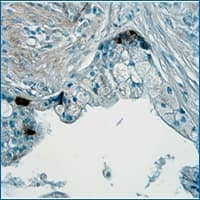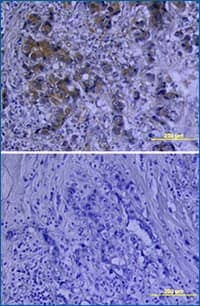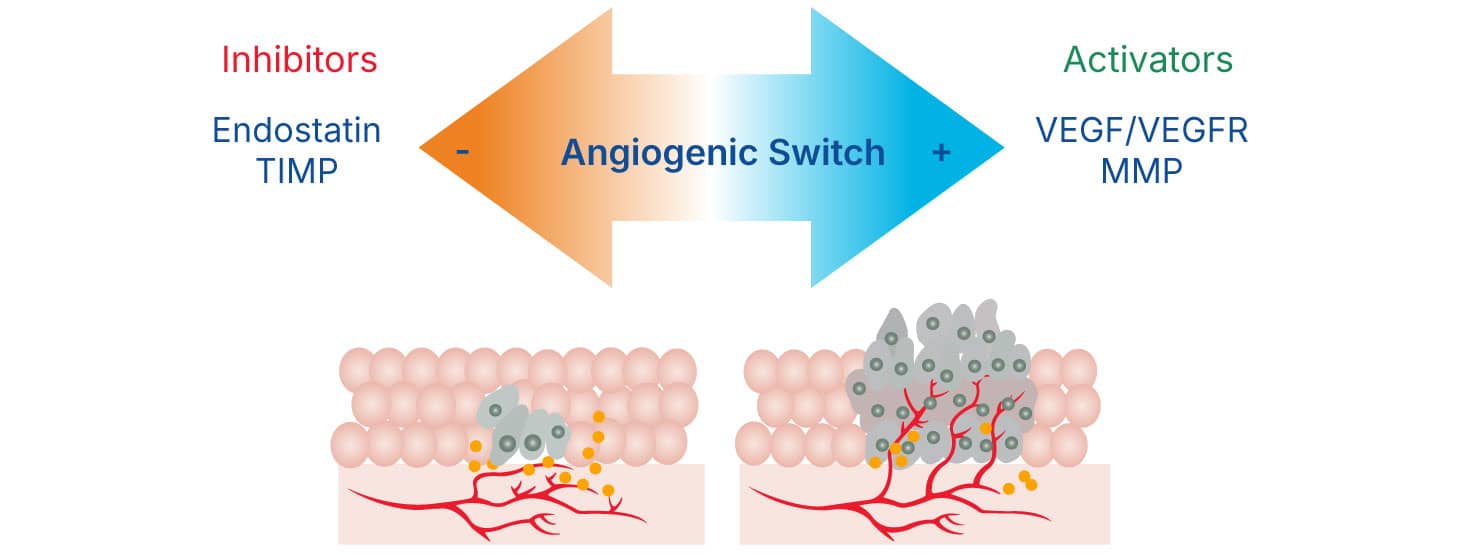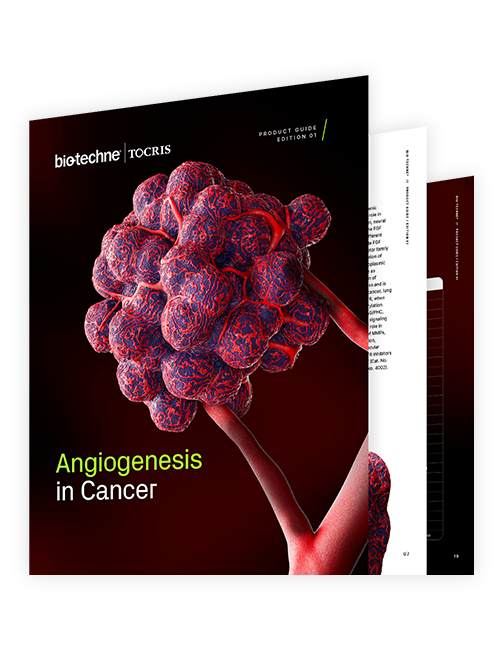Angiogenesis in Cancer
Angiogenic Switch | Featured Products | Endogenous Activators & Inhibitors
The survival of cancer cells critically depends on vasculature and blood supply which provide essential nutrients and oxygen to support the typically accelerated tumor growth. Additionally, vascular structures (e.g., new vessels, pre-existing vessels and vessel-like structures) allow cancer cells to travel to distant tissues and organs supporting cancer spread. Formation of new vasculature, or angiogenesis, is therefore a process that contributes to tumor growth and metastasis and is particularly critical for solid tumors.
“Angiogenic switch” refers to the activation of molecular pathways that direct the formation of new vessels within a tumor. Specific genetic changes in tumor cells underscore the activation of angiogenic programs by tilting the balance between the activity of angiogenic activators and inhibitors.
Within the angiogenesis cascade, different molecular factors play key roles in the establishment of new vessels. For example, VEGF is a critical angiogenic growth factor which stimulates the proliferation and survival of endothelial cells. In the tumor microenvironment, VEGF expression may be stimulated by hypoxia via the stabilization and activity of HIF transcription factors. Release of VEGF stimulates the concomitant secretion of proteases (e.g., Metalloproteinases- MMP-9) by endothelial cells of mature vessels which degrade the extracellular basement membrane and facilitate the movement and proliferation of endothelial cells. Under the influence of VEGF and other growth factors as well as adhesion molecules (e.g., Integrins) endothelial cells proliferate and migrate to give rise to new vessels.

Angiopoietin-1 was detected in immersion fixed paraffin-embedded sections of human prostate cancer tissue using 15 µg/mL Goat Anti-Human/Mouse Angiopoietin-1 Antigen Affinity-purified Polyclonal Antibody (Catalog # AF923) overnight at 4 °C. Tissue was stained with the Anti-Goat HRP-DAB Cell & Tissue Staining Kit (brown) and counterstained with Hematoxylin (blue; Catalog # 5222).

VEGF was detected in immersion fixed paraffin-embedded sections of human breast cancer tissue using Human VEGF 165 Polyclonal Antibody (Catalog # AB-293-NA) at 15 µg/mL overnight at 4 °C. Tissue was stained using the Anti-Goat HRP-DAB Cell & Tissue Staining Kit (brown) and counterstained with Hematoxylin (blue; Catalog # 5222). Lower panel shows a lack of labeling if primary antibodies are omitted and tissue is stained only with secondary antibody followed by incubation with detection reagents.
Endogenous Modulators of Angiogenesis
|
Angiogenic Modulators |
Activators |
Inhibitors |
|---|---|---|
|
Oncoproteins |
||
|
Growth factors |
VEGF-A, FGF, PDGF, EGF, Angiopoietin-1 |
|
|
Cytokines |
||
|
Microenvironmental factors |
||
|
Transcription factors |
||
|
Other modulators |
Thrombospondin-1, Chitinase-3-like 1, sFRP-4, Angiopoietin-2, TIMP |
Selected References
Avraamides, C. J., Garmy-Susini, B., & Varner, J. A. (2008). Integrins in angiogenesis and lymphangiogenesis. Nature Reviews Cancer. https://doi.org/10.1038/nrc2353
Folkman J. Tumour Angiogenesis. In: Mendelsohn J, Howley PM, Israel MA, Liotta LA, eds. The Molecular Basis of Cancer. Philadelphia: WB Saunders, 1995:206-32.
Ksenya, S., & Gerard, Evan. (2007). Tumor Angiogenesis: Cause or Consequence of Cancer? Cancer Res. https://doi.org/10.1158/0008-5472.CAN-07-2053
Muley, A., Majumder, S., Kolluru, et al. (2010). Secreted frizzled-related protein 4: An angiogenesis inhibitor. American Journal of Pathology. https://doi.org/10.2353/ajpath.2010.090465
Nishida, N., Yano, H., Nishida, T., et al. (2006). Angiogenesis in cancer. Vasc Health Risk Manag. PMID: 17326328
Pezzella, F., Gatter, K., & Qian, C. N. (2016). Twenty years after: The beautiful hypothesis and the ugly facts. Chinese Journal of Cancer. https://doi.org/10.1186/s40880-016-0087-1
Qian, C. N., Tan, M. H., Yang, J. P., & Cao, Y. (2016). Revisiting tumor angiogenesis: Vessel co-option, vessel remodeling, and cancer cell-derived vasculature formation. Chinese Journal of Cancer. https://doi.org/10.1186/s40880-015-0070-2
Rak, J., Yu, J. L., Klement, G., & Kerbel, R. S. (2000). Oncogenes and angiogenesis: Signaling three-dimensional tumor growth. Journal of Investigative Dermatology Symposium Proceedings. https://doi.org/10.1046/j.1087-0024.2000.00012.x
Yadav, L., Puri, N., Rastogi, V., Satpute, P., & Sharma, V. (2015). Tumour angiogenesis and angiogenic inhibitors: A review. Journal of Clinical and Diagnostic Research. https://doi.org/10.7860/JCDR/2015/12016.6135

